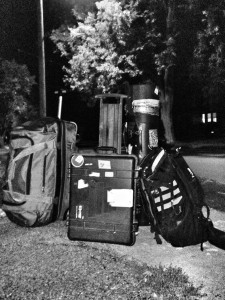My wife calls me a gear head, a gear hoarder, a gear junkie– anything that implies I like to buy gear. She’s right. But I like to argue, whether it is for myself or for her, everything I buy has a purpose. This week, I’m heading to Alaska for a month to cover the Iditarod. On this trip, more than most others, gear is necessary. Lots of it. Packing it all up to take on the road becomes a giant jigsaw puzzle. And since I’ve become somewhat of an expert on the topic of being a pack mule, I thought I’d share some strategies.
I have a rather large collection of bags that range in size from satchel to “hike across the country and bring the kitchen sink”. Each one has its purpose, but there is no such thing as the perfect bag. Which brings me to the camera world. How do you pack your camera for the constantly varying jobs?! The following ideas are mostly focused around my RED Epic kit, but it applies to most cameras in the digi cine realm.
First off, if I am staying local, and the shoot is really run and gun, I like to keep my camera fully assembled and ready to shoot. If I know my lenses are going to stay in the 50-85mm range, I will often use the Porta Brace HK-1. Its a great bag that allows you to throw your camera in it fully assembled and bring a couple accessories as well. You can throw it on your back and hike for a couple miles as well, if you really wanted to. The downsides to this bag are when you start adding longer lenses, and you need a lot of accessories. The longest lens I can fit in it is a Canon 30-300mm zoom, and even then you have to do a little finagling to get it in correctly. When you have to figure in filters, matte box, follow focus, batteries, FOOD (can’t go all day without food!) and all the other odds and ends, you are really starting to find its limits.
For shoots where I have a longer set-up that won’t fit in the HK-1, I have spent a while trying to refine. I went from the CineBags system to F-Stop, and then found myself recently trying out TrekPak. Cinebags didn’t quite cut it for me. They seemed a little flimsy, and the pockets fell apart pretty quickly. I am often running around, constantly taking the bags on and off, and I don’t want to worry about a bag ripping apart on me in the field. Cinebags did that to me in remote Alaska, calling for the ol’ duct tape fix to finish the shoot. F-stop is gold standard. I really do like them, but the are expensive. I currently have the biggest model, the Satori, but not with the internal compartments– just the open camera compartment. I can fit a disassembled Epic inside it, and used to do that as a carry on. But I really don’t like breaking my gear down that much just to move locations.
Overall, the TrekPak system seems to fit the bill. It has a fully customizable internal compartment through the patented “pull tab” feature. So if I have something that needs a snugger fit, I just pull the tab, adjust accordingly and put the tab back in place. Done. How is this better than the traditional velcro system? I feel like it’s way more secure, and rigid once assembled. When you have six batteries, an expensive EVF and a lot of other fragile parts, you don’t want velcro giving out, or the padding to buckle and start rubbing against everything. TrekPak has very rigid and secure dividers that offer plenty of protection. The downside is its a bit more narrow and you can’t cram it as full as the F-Stop bag.
It doesn’t matter how great your shooting skills are. If you don’t have the right tools ready to go, you’re going to miss the mark. I’ve seen some really great shoots go down the tubes because the proper equipment was missing. Don’t let that happen to you. No two shoots are the same, so spend some time figuring out not only what gear you need, but the best strategy for lugging it all around.
